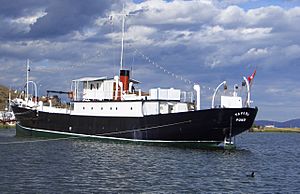Yavari (ship) facts for kids

Yavari at Puno in 2005
|
|
Quick facts for kids History |
|
|---|---|
| Name | SS Yavari; MV Yavari |
| Namesake | Javary River, Peru |
| Owner | The Yavari Project |
| Port of registry | |
| Route | across Lake Titicaca |
| Ordered | 1860 |
| Builder | Thames Ironworks and Shipbuilding Company |
| Launched | 1870 |
| Completed | 1862 |
| Status | Museum ship |
| General characteristics | |
| Displacement | 140 |
| Length | 100 ft (30 m) when launched in 1870; lengthened to 47.5 m in 1914 |
| Beam | 5.18 m |
| Installed power | 2-cylinder steam engine until 1914; then Bolinder 4-cylinder 320 bhp (240 kW) hot bulb engine |
| Propulsion | screw |
The SS Yavari is an old iron steamship built in Britain. The government of Peru ordered her in 1861 to sail on Lake Titicaca. She had a sister ship named Yapura. The Peruvian Navy used both ships.
The Yavari is named after the Javary River in Peru. This river is near the border with Brazil. The Yavari was the first steamship to sail on the highest navigable waters in the world. Today, the ship is a museum. You can even stay overnight in its cabins! It is the oldest iron lake steamer still sailing.
Contents
Building a Ship for the Sky
In 1862, a company called Thames Ironworks built the Yavari and Yapura. They were made of iron. These ships were designed to carry cargo and passengers. They could also act as gunboats for the Peruvian Navy.
How Ships Were Shipped
The ships were built in a special way called "knock down" form. This means they were first put together with bolts at the shipyard. Then, they were taken apart into thousands of pieces. Each piece was small enough to be carried by a mule.
The parts for both ships weighed a lot in total. They were sent by ship to the Pacific Ocean port of Arica in Peru. From there, a railway carried them about 40 miles to Tacna.
The Long Journey to Lake Titicaca
After Tacna, the journey became much harder. Mules had to carry the parts for 220 miles. They traveled over mountains to Puno, which is on Lake Titicaca. The lake is very high up, at 3,812 meters (about 12,500 feet) above sea level.
The original company hired to move the parts failed. So, the journey with the mules did not start until 1868. The first parts of the Yavari's hull were laid in Puno in 1869. The Yavari was finally launched in 1870. Her sister ship, Yapura, was launched in 1873.
Ship's Power and Changes
When first launched, the Yavari was 100 feet long. She had a 60-horsepower steam engine. This engine was special because it ran on dried llama dung!
In 1914, the Yavari's hull was made 15 meters longer. This helped her carry more cargo. At the same time, her old steam engine was replaced. She got a new Bolinder four-cylinder engine. This new engine was a 320-horsepower hot bulb engine.
Life and Times of the Yavari
The Yavari served Peru for many years. Her story includes times of peace and conflict.
The War of the Pacific
After the War of the Pacific ended in 1883, some Peruvian leaders continued to resist. They boarded the Yavari and Yapura on Lake Titicaca. They hoped to get more support from Bolivia.
However, Chilean forces arrived in Puno. The local leaders quickly gave up the city. The Chilean forces even brought their own small boat, the torpedo boat Colo Colo, to Lake Titicaca. They used it to patrol the lake.
Changing Owners
After the war, Peru's government was not rich. So, in 1890, investors from the UK formed the Peruvian Corporation. This company took over Peru's railways and lake ships, including the Yavari.
In 1975, Peru's government took back control. The Yavari and Yapura went to the state railway company, ENAFER. In 1976, they were given to the Peruvian Navy again. The Navy turned Yapura into a hospital ship and renamed her BAP Puno. But the Yavari was no longer used.
A New Life as a Museum
In 1987, some people who cared about history bought the Yavari. They wanted to restore her. Today, she is docked at Puno Bay. She is a museum where tourists can stay. She is still being fully restored.
In 2015, the restoration was almost finished. A group of young people from London followed the original route of the Yavari. They trekked over the Andes mountains from Tacna to Puno. They even took part in a "second maiden voyage" on Lake Titicaca. The British Ambassador to Peru joined them for this special trip.
See also
 In Spanish: Yavarí (cañonero) para niños
In Spanish: Yavarí (cañonero) para niños

